Characterization and Classification of Castoff Spatter from Kitchen Knives
Introduction
Blood spatter is defined as a distribution of bloodstains that indicate, through a specific arrangement, how the pattern was created [1]. Interpretation of blood spatter and its different patterns plays a crucial role in crime scene reconstruction. For example, the ratio of width to length of a drop can indicate the angle at which the blood drop fell [1]. The direction an elongated blood drop points in can also indicate direction of travel. Furthermore, the convergence of all the drop angles can be used to determine the location of a blood-letting event, such as an injury. Blood spatter may indicate which blood vessel has been cut. Arterial gushing results from blood leaving the body under extreme pressure, while venous blood is under much less pressure and therefore moves less quickly [2]. Arterial spurts, therefore, often appear in parabolic patterns, and venous blood as a passive drop or flow. Another type of pattern, castoff spatter, results from blood drops leaving an object due to its motion. Castoff spatter is created when the centrifugal force, acting outward around a single point, on a blood drop is enough to cause the blood to leave an object [3]. This object can be a weapon or another substrate, such as hair. The swinging motion of a bloodied object often causes a series of drops that then form stains in a linear or curvilinear fashion [3]. The motion of the swing will alter the location of the castoff pattern. For example, swinging a weapon over the shoulder will leave a castoff pattern on the ceiling, above the event. Swinging a weapon to the side will leave a pattern on the wall or floor.
Several factors may affect a castoff spatter pattern. The force of motion of a bloodied object, as it is directly associated with speed, can affect the length of the pattern created [4]. This force often exhibits a positive correlation with the size and strength of a perpetrator. The greater the force, the greater the speed, also seen as a greater centrifugal force. The greater the centrifugal force, the smaller the blood drops and longer the castoff trail. The dimension of a location can also affect the dimensions of a pattern. If a ceiling is too high, there will not be enough force acting of the blood drops to act against gravity and create a castoff pattern. The volume of blood upon the weapon, will further affect the pattern length. The less blood available, the shorter a castoff pattern trail. Studies have been done to correlate the width of the weapon to the castoff spatter created [2]. These studies showed that the spatter itself will be wider, in that the drops are a further width from each other, as the weapon widens. An example of this is seen in the difference in patterns created by a baseball bat, with a substantial width, and a knife, with a comparatively minimal width. For the purposes of visualization, the bat will create a pattern similar to footsteps that are shoulder width apart, while the knife would be akin to footsteps walking on a line.
Environmental factors, such as substrate composition, can also affect castoff spatter. Laundering, or the lack thereof, can affect the wicking and spreading of a blood spatter upon a fabric surface due to factory treatments, such as pre-laundering, which may widen the area of individual spatter [5]. The final stain areas are also affected by the composition of the fabric. Due to the physical properties of different thread types such as cotton and polyester, the blood will spread at different rates [5]. This will affect the dimensions of elongated bloodstains, which will alter the angle of impact calculations, should they be done. In the case of castoff spatter, the exact angle of blood drops is of less concern, as the parabolic nature of the pattern itself lends information to the location of incident. The blood drops in the pattern that are perpendicular to the location of the event are more circular, with blood drops to either side gradually elongating. Studies have been performed to compare the results of synthetic blood versus bovine blood in forensic research [6]. Blood spatter is affected by three basic physical properties: surface tension, viscosity, and density [7]. Surface tension is based on the attraction of particles in a liquid to one another. The higher the surface tension, the more force it takes for a liquid to break into smaller drops. Density, or the mass per unit of volume, plays a role in the viscosity of a liquid. Less dense liquids, such as water, will move more freely when an external force acts upon it than a denser liquid, such as blood. Due to the composition of blood, with plasma, cells, and particles of cells, it is considered a non-Newtonian fluid [7]. That is to say, that the viscosity, or thickness, of blood varies depending on the force applied to it. Synthetic blood, however, tends to be more like water, a Newtonian fluid, and therefore creates a different castoff spatter pattern than that of bovine blood6. Certain types of synthetic blood, specifically those with silicon additives, have been shown to be sufficient substitutes in terms of viscosity and density when used in passive drip recreation [8]. Passive drip reactions, however, do not apply an external force to the liquid, but rather allow gravity to affect the drop. Both theatrical, a water based substitute, and bovine blood were used in this study to further investigate this topic. While research has been done on the effect of the length of a weapon on castoff spatter, there has been little research on the length of a weapon on castoff trails. Likewise, while research has been done to compare blood to blood substitutes in passive situations, little research has been done to compare them when an external force has been introduced. The aim of this study was to analyze the castoff spatter of three kitchen knives, using both theatrical and bovine blood.
Materials & Methods
Room Setup and Blood
A room was created using Polyvinyl Chloride (PVC) pipes and painter’s plastic to the dimensions of 97 inches long by 45.5 inches wide by 94 inches tall (Figure 1). Unlaundered queen-sized flat sheets were cut in half and hung from the ceiling using twine threaded through clothespins. These sheets made for a removable castoff spatter canvas with consistent dimensions and shape. Three knives were utilized in this study: a seven-inch knife (7in, 17.78 cm), a five-inch knife (5in, 12.70 cm), and a three-inch knife (3in, 7.62cm). The length measurement is that of the knife blade and the width of the blade was the same for all three knives (Figure 2). Width was determined by holding the blade perpendicular to the floor, poised to cut, and looking down at the blade. All knife blades were the same brand, previously unused, and made of stainless steel with a similar smooth surface. The 7” knife had a serrated edge. A stool was placed at one end of the room to set the knives and containers of blood on. Two different types of blood were used: theatrical blood (Vampire Blood) and defibrinated bovine blood (Carolina Biological Supply Company). The theatrical blood, produced with hydroxyethyl cellulose and propylene glycol, was chosen due to its accessibility and cost. Defibrinated bovine blood, treated by removing the clotting factor fibrin, was chosen due to its current use in the bloodstain pattern analysis field.
Figure 1:Room setup. The measurements of the room as well as the location of the supplies are shown. All the six sides of the structure were covered with the painter’s plastic. A door was created with a flap of plastic for easy access. A window was also created opposite to the door for photo taking.
Figure 2:Kitchen Knives. The lengths of the knives used, from left to right : a seven-inch knife (7in, 17.78 cm), a five-inch knife (5in, 12.70 cm), and a three inch knife (3in, 7.62cm). All knives had the same width and had a steel blade.
Procedure
For every trial, the knife was dipped into the blood container all the way to the hilt of the handle and allowed to drip off a set number of drops (7 in = 10 drops, 5 in = 8 drops, 3 in = 6 drops). The average volume of the blood upon each knife length was also determined. The blood was allowed to drip off as per procedure, then the remaining blood was scraped into a beaker that had been previously weighed. The beaker and blood were weighed. The difference of weight was converted to volume using the known density of blood. Immediately after the last drop, the knife was swung over the shoulder in imitation of coming back from an overhand stabbing. That is to say, the knife was held with a stabbing grip, so that the fingers were over the handle, not under. The force exerted in the backswing was made consistent by using the same individual (height 5’2”) who did not overexert herself in the trials. This motion left a castoff spatter on the sheet attached to the ceiling. The sheet was then detached and allowed to dry. The knives were cleaned between trials by wiping them off with paper towels. For the next trial, the sheet was replaced, and the procedure repeated for a total of five trials for each knife. The procedure was repeated with both theatrical and bovine blood for all three knives. Again, five castoff spatters were created with each knife.
Data Analysis
After the sheets were allowed to dry, measurements for the total length of the trail (in cm), and the number of individual drops within the trail were made. The length of each drop within the trail was recorded (in mm). GraphPad Prism 7 was used for t-test and One-way ANOVA analysis.
Results
A measurement of the average volume of blood was used to determine the blood available for castoff spatter (Table 1). Theatrical blood consistently had a higher volume of blood than bovine blood. The length of the knife had a positive correlation to the volume of blood upon the blade. Consistent force was exerted to the backswing for each trial. For the three-inch knife, the force exerted did not create a spatter on the sheet above therefore no data was included (Table 2). With both bovine and theatrical blood, the total length of the trail increased with blade length. The number of individual drops increased with blade for bovine blood. However, the total number of individual drops decreased in theatrical blood. Qualitative analysis of the castoff spatters (Table 3) showed that the space between individual drops increased the further they were from the beginning of the trail in bovine blood while decreasing in theatrical blood trails. Castoff spatter made with theatrical blood formed a ‘tail’ in which blood drops ran together (5/5 in 7-inch knife’s and 2/5 in 5-inch knife’s trials) (Figure 3). Bovine blood formed individual drops up to the end of the trail (5/5 for 5 and 7 inch knife lengths).
Table 1: Blood Volume on Knives. An average of the amount of blood on each knife length by blood type (n=5).
Table 2: Total Length and Number of Drops for Each Trial. A qualitative comparison of bovine and theatrical blood for both five and seven inch blade lengths. The three-inch knife did not provide data.
Table 3: Qualitative Analysis of Blood Trails. A comparison between the trails of Bovine and Theatrical Blood based on general appearance regardless of knife length. Distance between drops is demonstrated with dots. Trail length is the length of the pattern, from the first to last drop. A tail was formed when the last drops of a trail ran together. Drop length represents a comparison of the length of individual drops.
Quantitative data shows that when measuring the length of the first six individual drops, the theatrical blood tended to have longer drops in both five and seven inch knife lengths (t-test, p = 0.3 in 5 in, p = 0.1 in 7 in, n = 30 in both scenarios) compared to bovine blood, but with no significant difference (Figure 4). In terms of the total length of the trails (Figure 5), theatrical blood showed a shorter trail than bovine blood (t-test, p < 0.01, n = 5 for all scenarios). Because the individual drops could not be distinguished for the purposes of counting, the “tail” on the theatrical blood was not included when measuring the length of the castoff, thereby leading to the shorter trails. In terms of bovine blood, a tendency of longer trails for longer knives was seen, but there is no statistical difference (t-test, p = 0.11, n = 5 with each scenario). The number of individual drops in each trail of bovine blood was dependent on the length of the knife (Figure 6). The longer the knife, the higher the number of individual drops in a castoff spatter (One-way ANOVA, p < 0.042, n = 5 for all scenarios). The three-inch knife produced zero drops on the sheet. Theatrical blood drop number was not analyzed due to the “tail” in each pattern in which individual drops could not be counted.
Figure 3:Representative Blood Spatter (7inch knife). Bovine blood a) Showed distinct, individual drops while theatrical blood. b) Formed a tail. Theatrical blood appeared to be less viscous and have less cohesive properties, making it more like water than like blood.
Figure 4:Individual drop length. Theatrical blood had longer individual drop lengths. Each bar is a representation of the average lengths of the first six drops for all five trials( SEM: t-test, p=0.3 in 5 in, p=0.1 in 7 in, n=30).
Figure 5:Total length of trial. Bovine blood had longer trial lengths (in cm) than that of theatrical blood. Each bar shows the total length average for five trials (**: t-test, p<0.01, n=5 for all scenarios).
Figure 6:The number of individual drops. Each bar shows the average number of individual drops (n = 5 trials) within a trail by knife length. (**: One-way ANOVA, p < 0.01).
Discussion
Blood was allowed to drip off each knife based on their length (7 in = 10 drops, 5 in = 8 drops, 3 in = 6 drops). Although in a real-life scenario, a knife would not drip off before being swung back, the knife would also not be covered in blood to the hilt. Allowing the blood to drip off assisted in normalizing the trials as well as allowed for individual drops within the castoff spatter. The average volume of the blood upon each knife was therefore determined based on this normalization. Theatrical blood consistently had a greater blood volume upon the knives. This is likely due to the cohesive force of the liquid as well as the density. While not noted, the serration of the 7 in knife may have affected the volume of blood on the knife. The serration would likely have provided a greater surface area, therefore increasing the area blood could adhere to the knife. The lack of castoff spatter produced with the three-inch knife is due to the force exerted on the knife. Although consistent to the force exerted on the other knives, it was not enough to fling drops high enough to reach the sheet. This effect likely coincides with blood volume. A lesser volume of blood on the knife leads to small blood drops, which would then require more force to overcome cohesion and reach the sheet to produce castoff spatter.
Theatrical blood behaved in a manner similar to water, not a non- Newtonian fluid. The results of theatrical blood in comparison to the results of bovine blood support previously published evidence that theatrical blood is not an adequate substitute for forensic recreations of castoff spatter. The greatest observable difference was the presence of a “tail” in some of the theatrical blood trails. This is likely due to the cohesive forces as well as the higher blood volumes in theatrical blood with all blade lengths. With a greater volume and lesser cohesion, it would have been more difficult for the theatrical blood to form individual drops in flight than for bovine blood. This would lead to individual drops connecting into one line, creating a “tail”. Differences in viscosity and cohesive forces between Newtonian and non-Newtonian fluids also affect the amount of blood present on each knife and could explain the results on length of individual drops and trail length. The total length of the trail is dependent on the length of the knife as well as the force exerted.
The longer the knife, the longer the total trail length will be due to higher blood volume. This is similarly seen in the theatrical blood. Despite the presence of a ‘tail’, which could not be measured, the longer knife, with a higher volume, had a longer measurable trail. Even though the “perpetrator” applied the same force in each trial, another variant was likely the force exerted. This may be seen when observing the intra-source variation of the trail length. In the future, it would be preferable to use an automated system in order to standardize force. An increase in the length of the knife increased the number of individual drops within a trail. This relates to the volume of blood that a knife of a specific length can carry. Therefore, the number of individual drops is dependent on the length of the knife blade. However, in theatrical blood, the length of the blade inversely correlates to the number of individual drops, not considering the “tail”. This is due to the “tail” which had no individual drops and was thus not counted.
Conclusion
This study can be a steppingstone to further research regarding castoff spatter. If the weapon is known to be a knife, with the data collected, a generalization can be made as to the length of the blade (short vs long). However, it is acknowledged that determining the type of weapon from castoff spatter alone is almost impossible. This study can lead to further research on the other factors that affect castoff spatter, such as force, blood volume, and ceiling height.
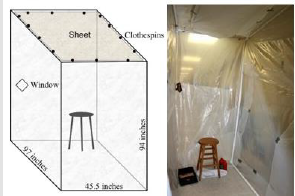
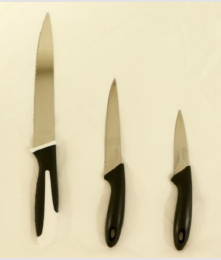


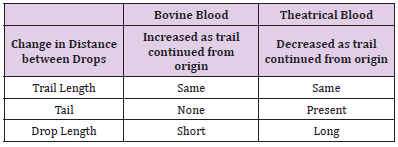
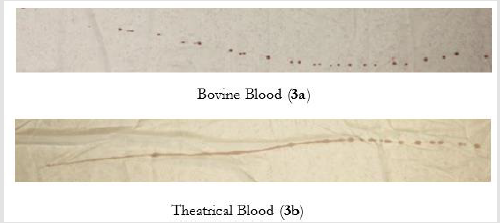
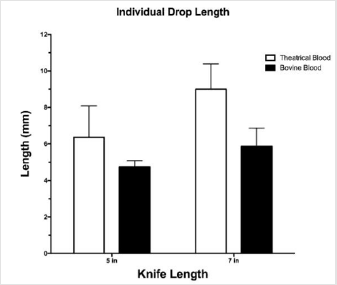
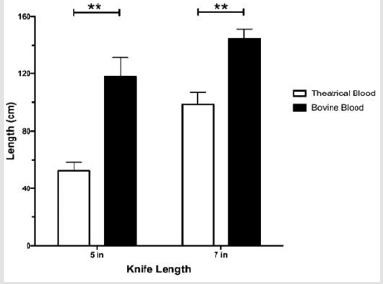
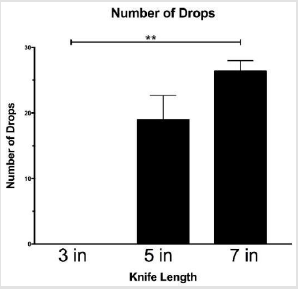
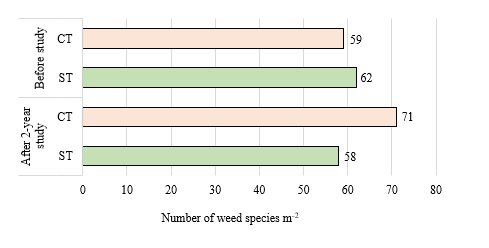

No comments:
Post a Comment
Note: Only a member of this blog may post a comment.